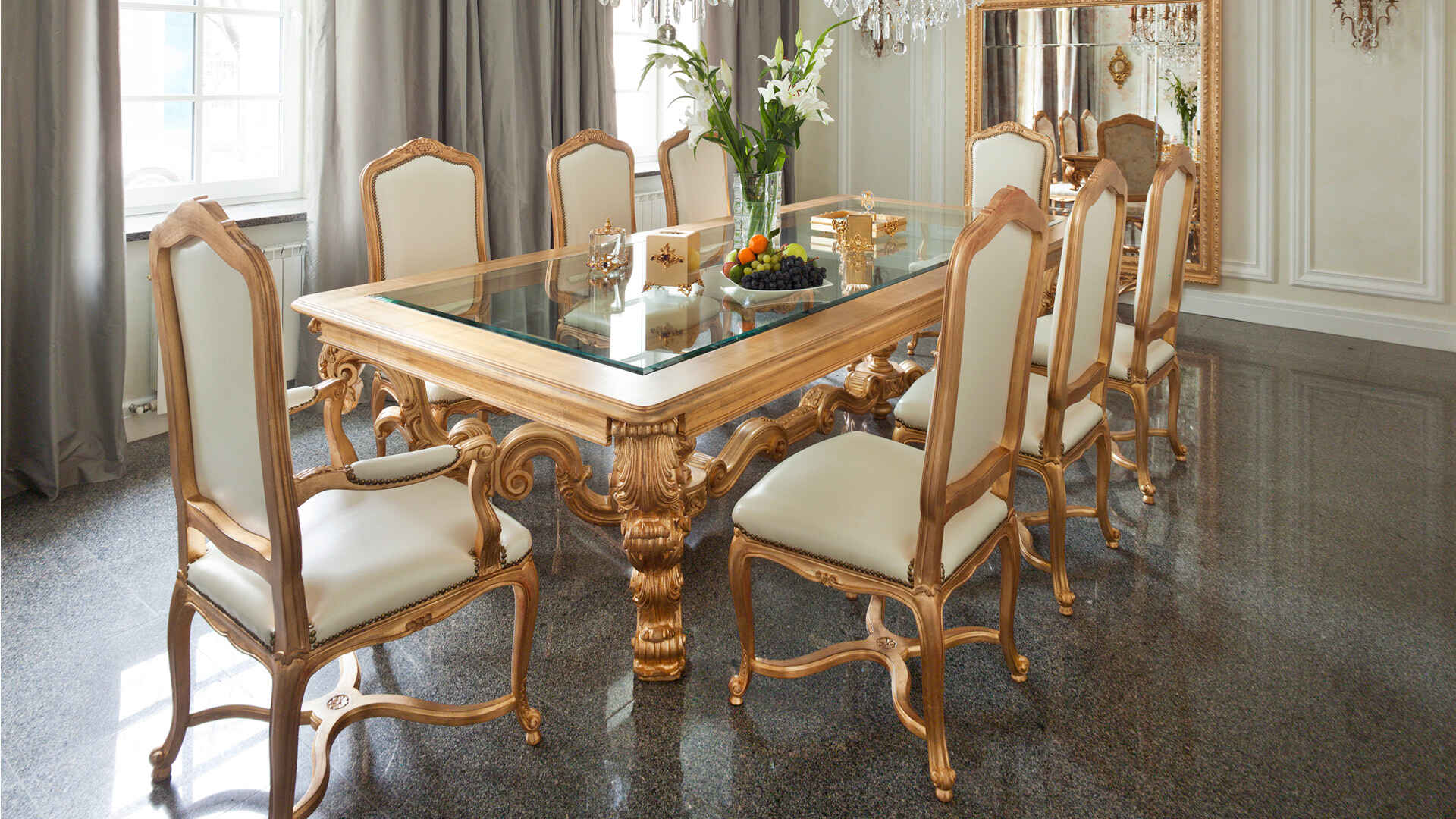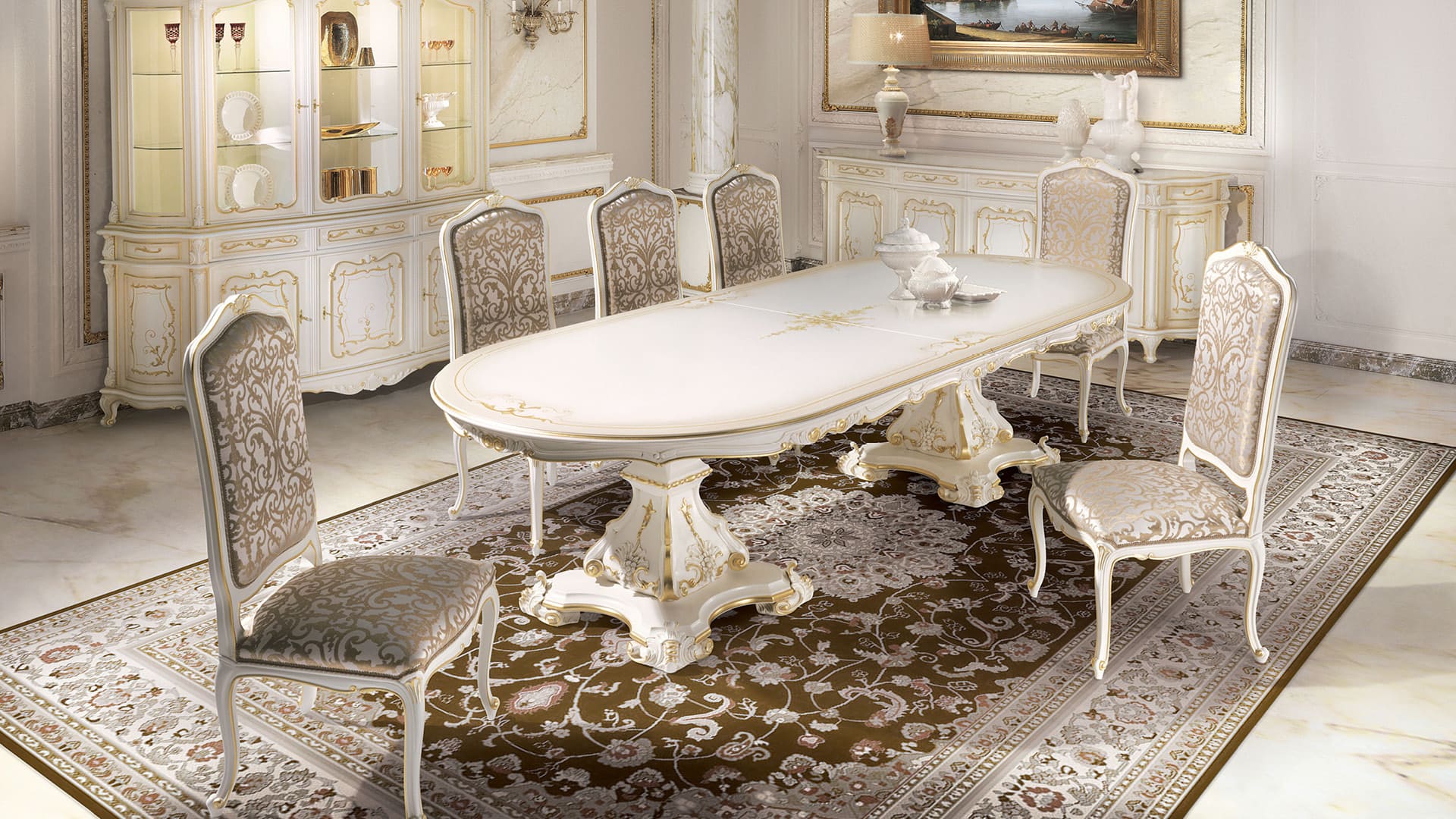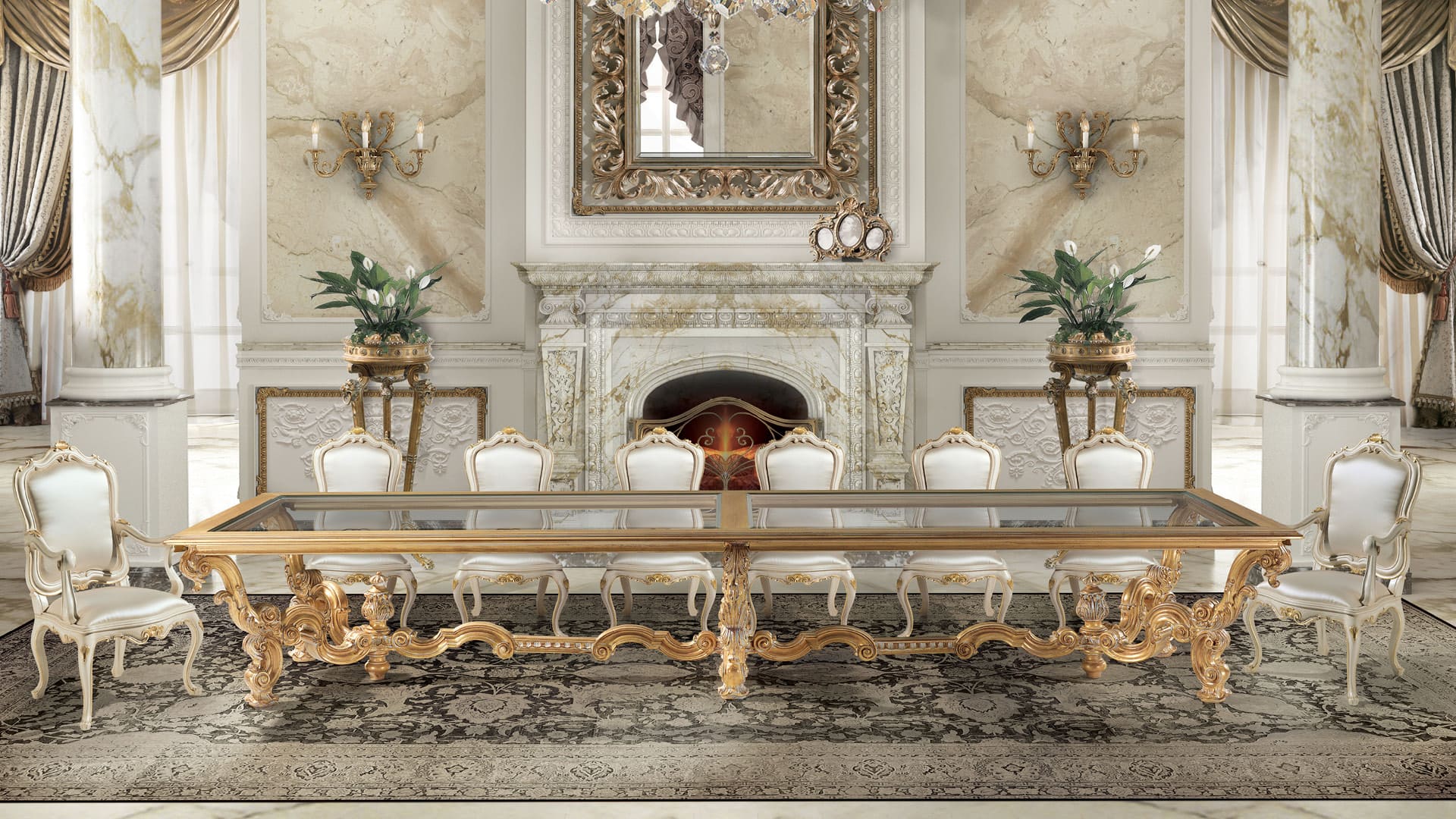
28 Nov Baroque-style dining room furniture
Baroque-style dining room furniture: statement pieces for sheer elegance
Styles come and go, in the world of interior design. However, some are considered enduring classics because of their ability to captivate both interior designers and end users with their unique allure, timeless elegance and overall ability to fully embody a space’s most profound identity.
One such style is Baroque, a sumptuous design movement that originated in the seventeenth century and, thanks to its indelible mark, has been influencing art, furniture design and architecture since then. Breaking away from the classicism of the Renaissance, the rich and ostentatious Baroque style permeated the European courts and noble families of the time, expressing its full potential in several settings thanks to its ornate detailing, exquisite craftsmanship and opulent aesthetics.
One of the environments where the Baroque style fully expresses itself is certainly the dining room: a space designed to host not just regular meals, but also lavish parties. Considering that dinner parties are an occasion to entertain in grandeur, nothing says “luxury dining room” like décor in the Baroque style. Even though not many homeowners choose a completely Baroque design, adding its touches and features to a luxury dining room will make it seem opulent and extravagant even in an eclectic, more contemporary-looking house.
Let’s explore the allure of Baroque-style dining room furniture, delving into the essence of this specific style and examining how it continues to inspire “current classic” and contemporary home design.
Understanding the Baroque style: a symphony of ornamental beauty
Before detailing how the Baroque style can enrich and enhance the appearance of a dining room, it’s essential to grasp the fundamental characteristics of this home décor.
As we previously reported, Baroque design emerged in Europe during the seventeenth century, flourishing from the late Renaissance to the early eighteenth century. Unlike the Renaissance’s more even, restrained and somehow rational approach, however, Baroque design is characterized by exuberance, theatricality and overall grandeur in all its expressions.
Among the key features of this style, it’s worth mentioning:
- Ornate detailing: Baroque design is always synonymous with intricate ornamentation, which includes elaborate scrollwork and intricately carved motifs (usually leaves, cherubs, flowers, but also human and animal figures). Generally speaking, Baroque furnishing will showcase a profusion of decorative elements.
- Rich materials: Baroque furniture is typically crafted from rich, luxurious, carefully selected materials and precious wood essences such as ebony, walnut, and mahogany. These rich, dark woods are often complemented by gilded accents that enhance the opulence of the pieces. Marble surfaces or covered in gold leaf are also widely used.
- Curvilinear shapes: Baroque interior design often features sinuous and curved lines that add a sense of movement and dynamism to the furnishing. S-shaped and C-shaped curves are pretty prevalent, lending a graceful and almost fluid quality to the pieces.
Dramatic contrasts: another feature that makes the Baroque style unique is the skillful interplay of light and shadow. Dark and polished surfaces are juxtaposed with gilded highlights, creating a visually striking contrast and enhancing the overall dramatic effect of the setting.
Dining rooms in the Baroque era: where opulence met indulgence
In order to fully understand why Baroque furnishing is among the most beloved home décor styles even in contemporary houses, it’s crucial to focus on the meaning of home settings in the original Baroque era. Back then, dining rooms were not just functional spaces where homeowners would consume their meals, but also theatrical stages for grand social events, private parties and lavish banquets.
The dining rooms of the Baroque period were designed and furnished to impress and awe guests and ultimately reflect the homeowners’ wealth and social status.
As a backdrop for sumptuous feasts that showcase the culinary prowess of the time, they included elaborate table settings, fine China and exquisite silverware that acted almost as ornaments to the dining tables, creating a multi-sensory experience that indulged both the palate and the eyes.
In their original interpretation, Baroque-style dining rooms often featured architectural elements such as ornate ceiling moldings, grand chandeliers, and elaborately carved paneling. These architectural embellishments added to the sense of grandeur and opulence, creating a captivating ambiance for guests. In addition, the meticulous craftsmanship and intricate carvings of the furniture made each piece a statement piece: for example, dining tables were typically adorned with elaborate pedestal bases, and chairs featured ornate backs and legs, showcasing the mastery of artisans of the time.
Finally, it has to be remembered that textiles also played a crucial role in the original Baroque dining rooms: draperies, curtains, and upholstery were crafted from rich and carefully selected fabrics such as silk, velvet, and brocade, adding a tactile layer of opulence to the space; while richly embroidered tablecloths and cushion covers further enhanced the visual splendor of the dining room.

Baroque-style dining rooms in current home design: a modern Renaissance
While the Baroque era may belong to the past, its influence continues reverberating in contemporary interior design.
Baroque-style dining rooms, with their ornate furniture and lavish detailing, have made a resurgence in modern homes, adding a touch of old-world charm and sophistication to contemporary spaces.
In today’s eclectic design landscape, designers often blend Baroque-style furniture with modern elements, creating a harmonious fusion of old and new. A Baroque-style dining table paired with sleek, minimalist chairs or a contemporary lighting fixture can elevate the overall aesthetic of the dining room, striking a perfect balance between opulence and simplicity.
In addition, Baroque furniture specifically designed for the dining room serves as statement pieces that anchor the entire room. A grand, intricately carved dining table becomes the focal point around which the rest of the decor revolves. Ornate sideboards, with their detailed carvings and gilded accents, provide functional storage while adding a touch of grandeur to the space. As for materials and color palettes, today’s Baroque still incorporates rich, deep colors such as burgundy, emerald green and royal blue. In modern Baroque-style dining rooms, these hues are used strategically as accent colors in upholstery and draperies or as bold statements on walls and decorative accessories. The deep, saturated tones create a sense of intimacy and coziness, making the dining room a welcoming retreat, while dark woods like mahogany and walnut remain popular choices, exuding a sense of refinement and elegance. To add a contemporary twist, designers often incorporate materials like marble and glass, creating a dynamic interplay of textures and finishes.
Ultimately, Baroque-style dining rooms in modern homes embrace opulence in subtle ways. Inspired by the grand lighting fixtures of the Baroque era, accessories such as crystal chandeliers cast a soft, ethereal glow, adding a touch of romance to the dining space. Mirrors with ornate frames enhance the sense of space and reflect the room’s beauty, creating a mesmerizing visual effect.

Angelo Cappellini for your Baroque-style dining room
Baroque-style dining room furniture stands as a testament to the enduring allure of this extravagant design movement. It elevates the dining experience, transforming mealtime into a grand affair. As Angelo Cappellini embraces the opulence and elegance of Baroque design, it pays homage to a rich cultural heritage and creates timeless, enchanting spaces that leave a lasting impression on both homeowners and guests.
For over a century, the Italian company has been designing and manufacturing a wide selection of luxury dining rooms in the most timeless classic styles, including Baroque.
The Canaletto collection, for example, is permeated by the sense of grandeur that is so profoundly intertwined with this home décor style. Rich details on every piece of furniture give it a finely unique quality: the table showcases two beautifully carved bases that support a top decorated with flowery designs, while elegant carvings and handcrafted ornaments enhance the curved and flowing forms of the sideboards and cabinets.
Florida is a Baroque-style dining room featuring prestigious classical connotations, especially enhanced by the solemn table with a Canaletto walnut top and precious floral inlays made of maple wood. The white finish with patinated gold details enhances the sinuous S-shaped legs and the profiles of the seats with backrests in natural-colored Vienna straw.
Finally, the Van Gogh Baroque Dining Room is an exquisitely detailed piece of art. The focal point of the space is the dining table, with its intricately carved cross structure: a manifestation of Angelo Cappellini’s extensive and profound expertise in perfectly replicating the richest pieces of classic interior design.
